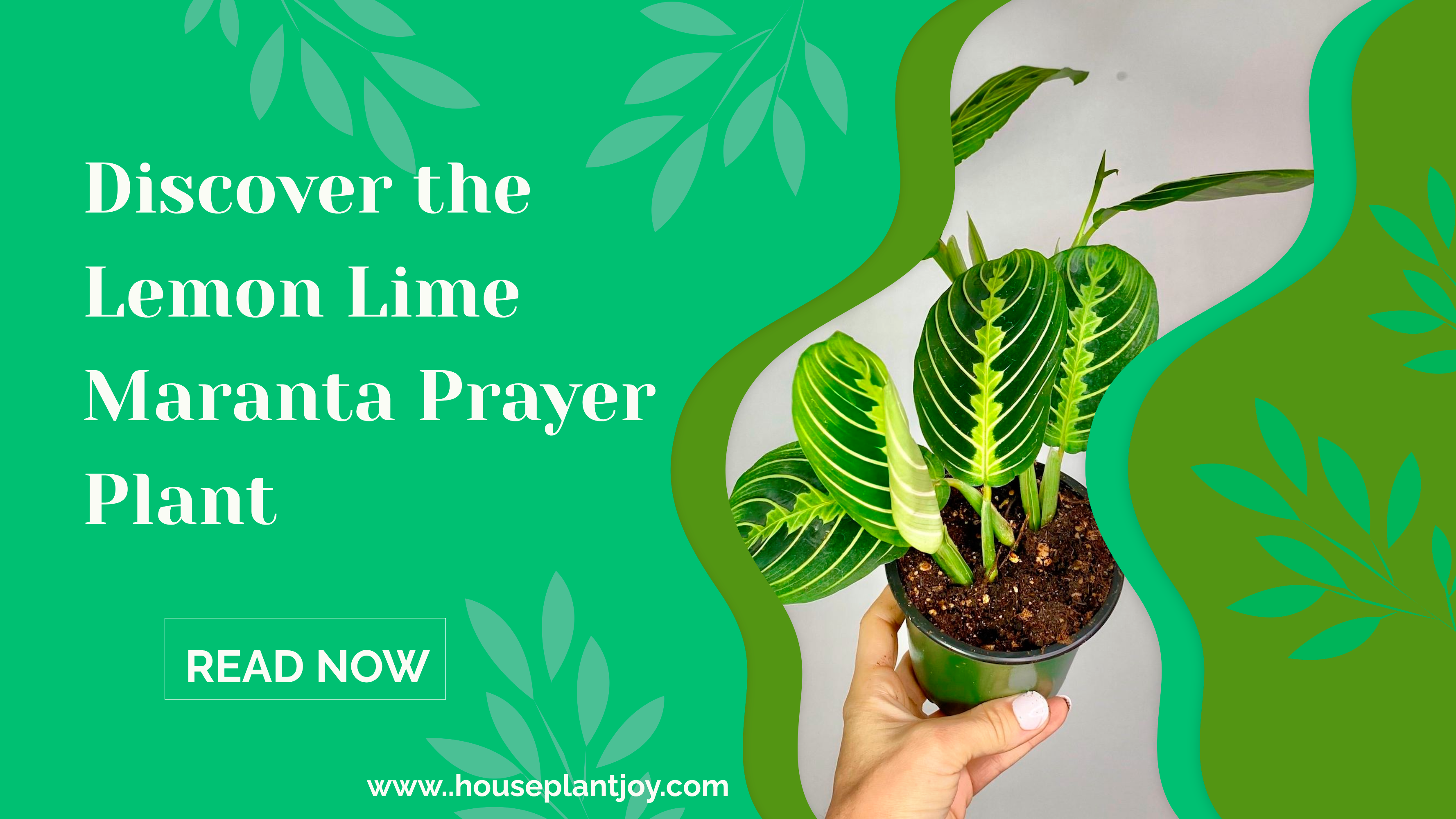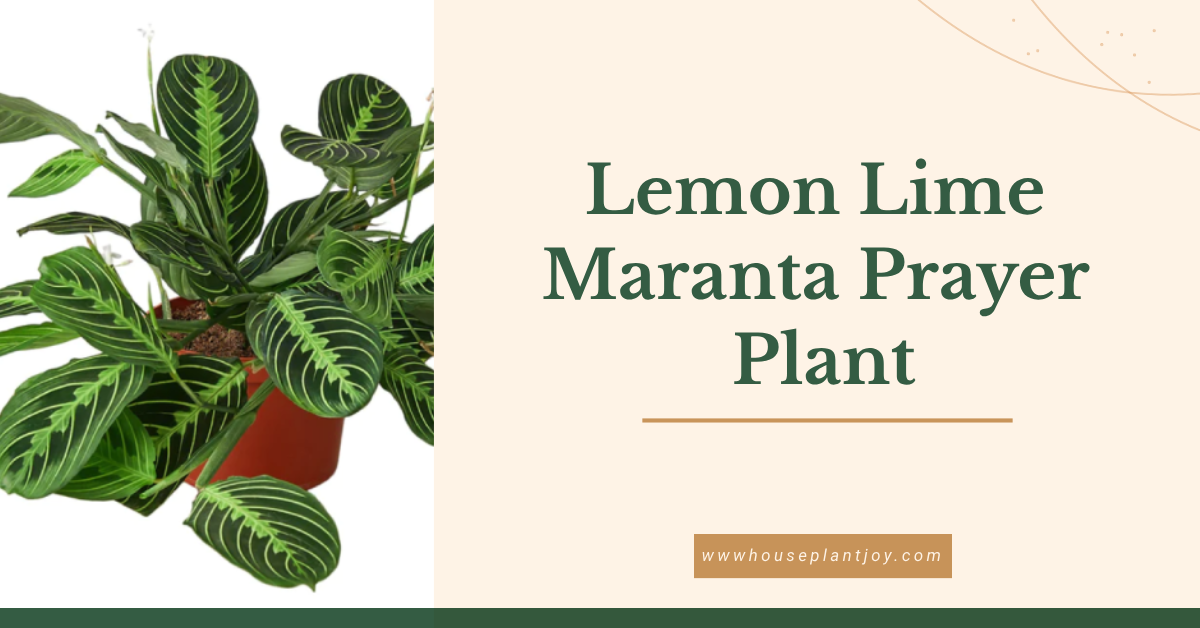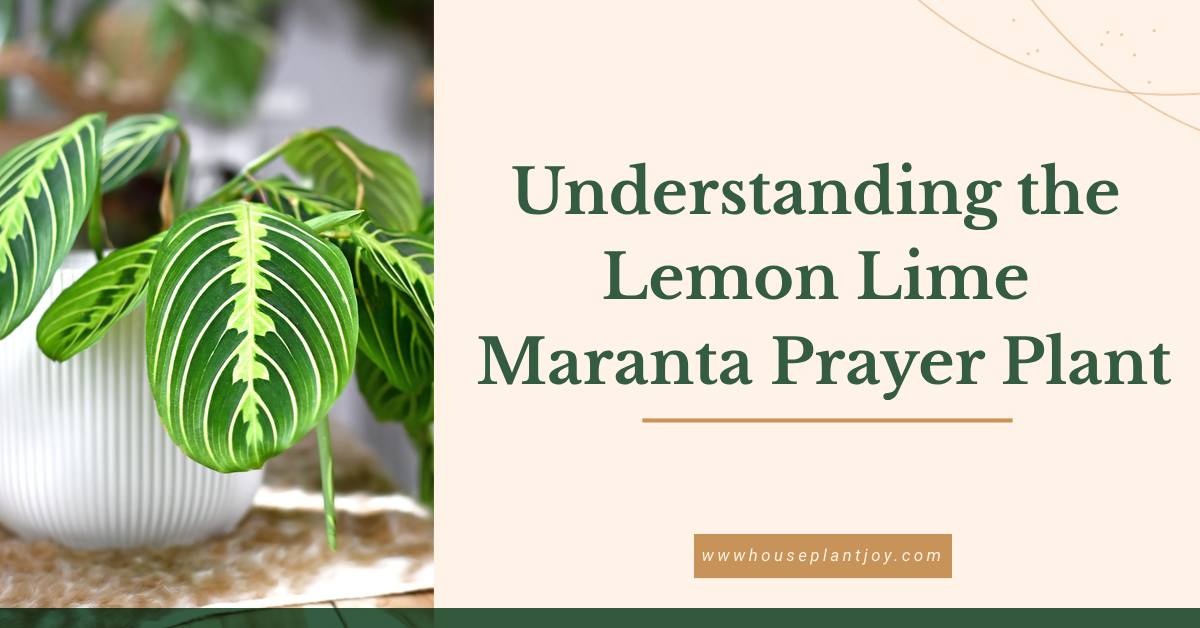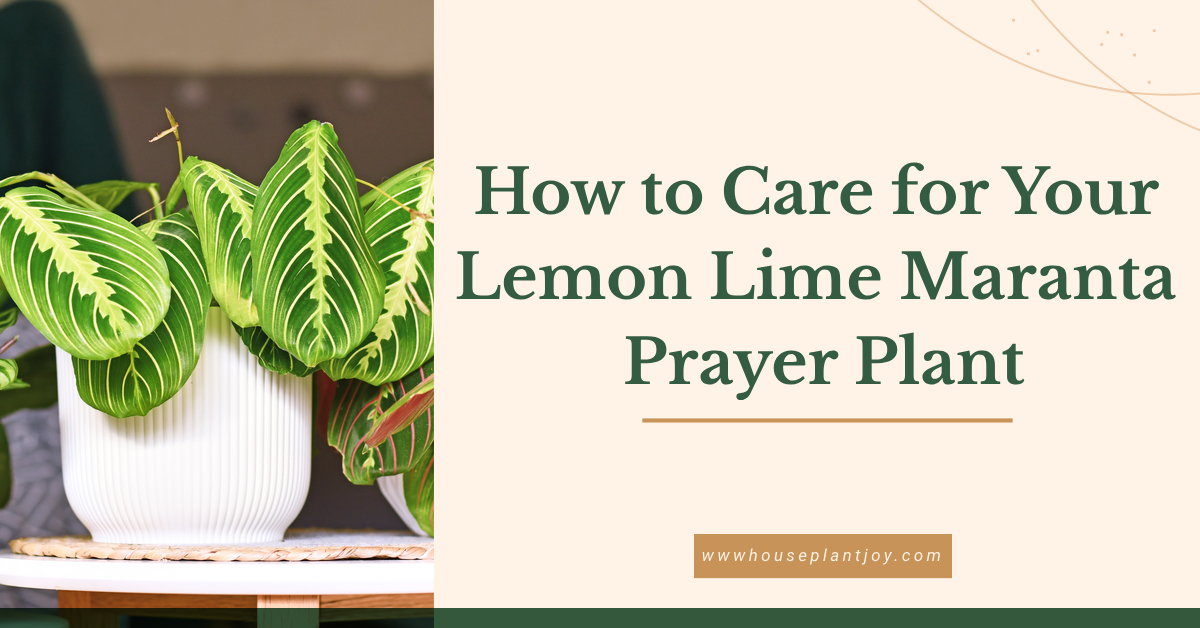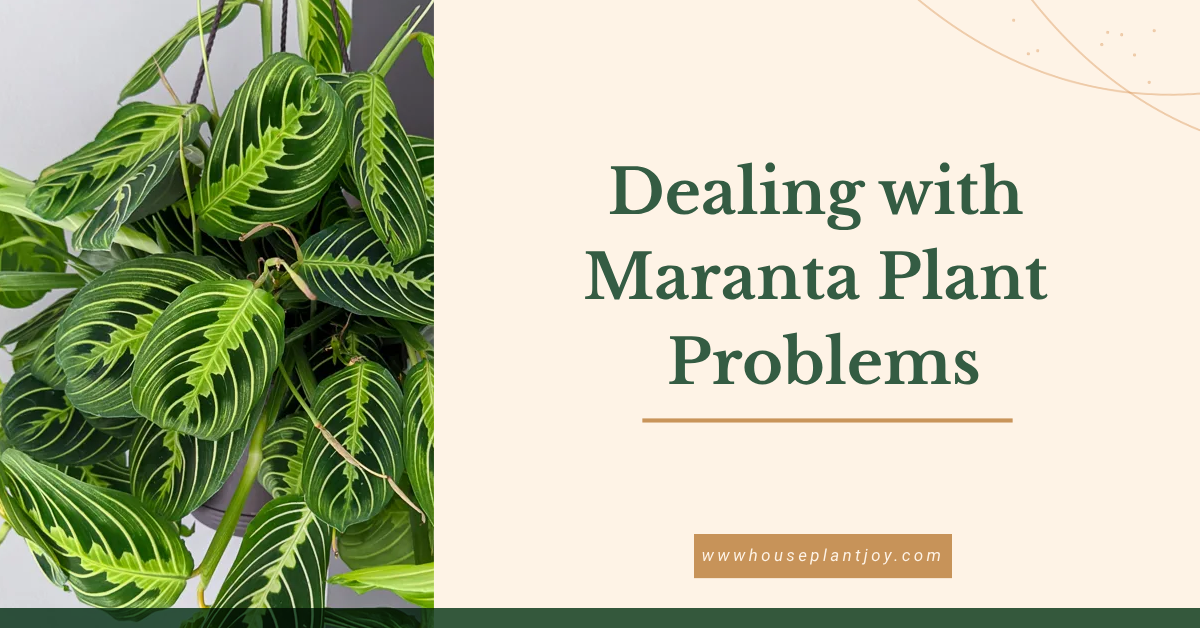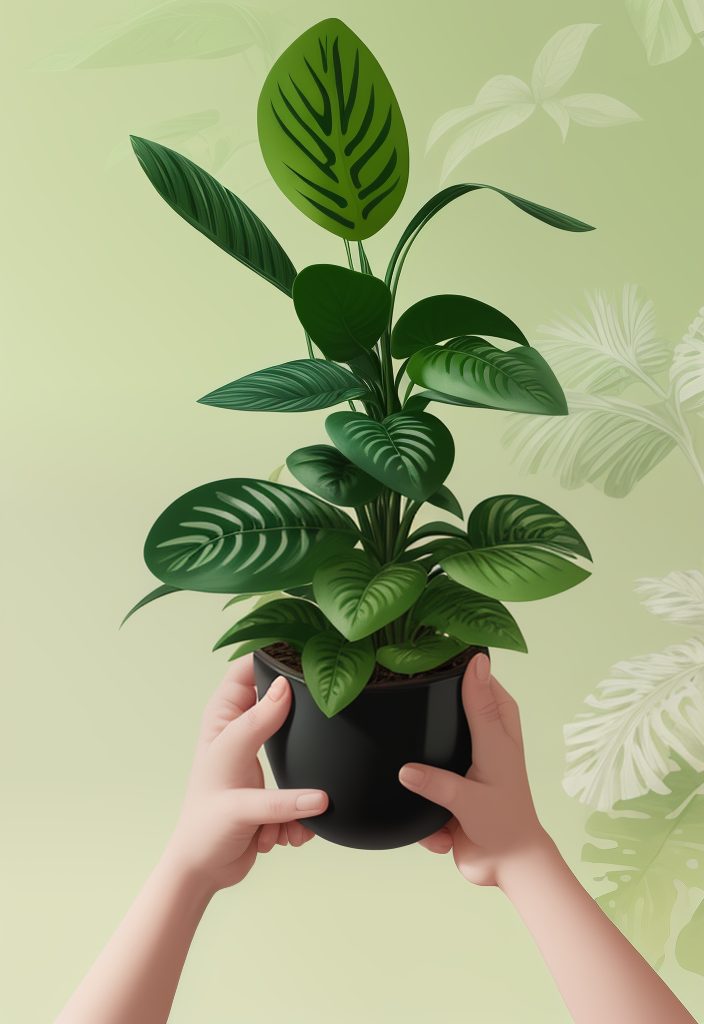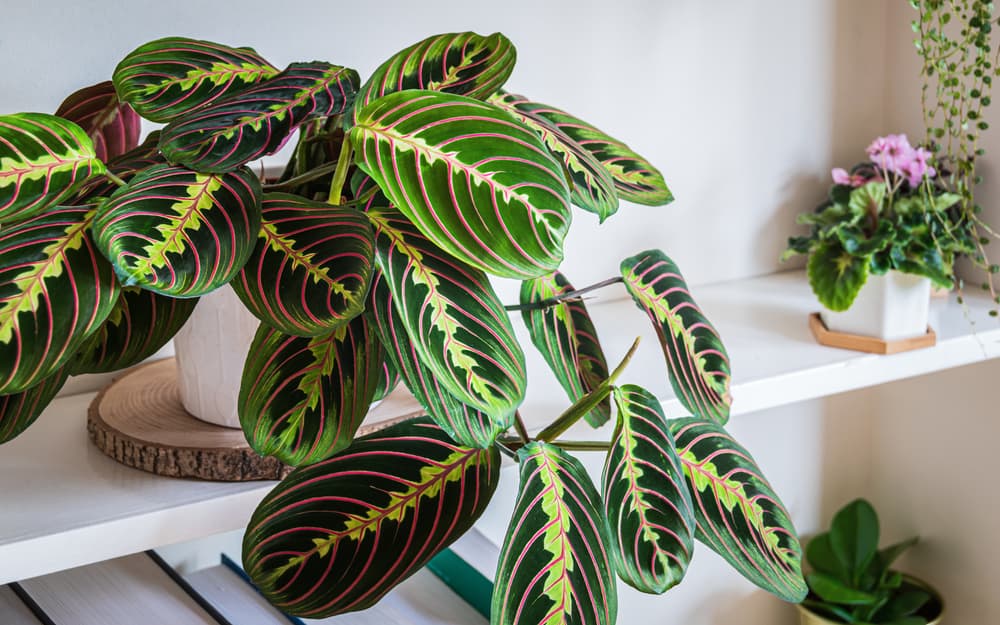HousePlantJoy is supported by our audience. When you purchase through one of our links, we may earn a small affiliate commission. As an Amazon Associate I earn from qualifying purchases. Your cost is not affected.
==================
In this blog post, we take a closer look at the Lemon Lime Maranta Prayer Plant. We explore its unique features that set it apart from other plants. And we also provide valuable tips on how to care for your plant, including ideal light and temperature conditions, watering and feeding requirements.
Additionally, we will address common problems faced by Maranta plants and how to overcome them. If you are wondering whether this plant is safe for children or pets, we have got you covered too! Keep reading to discover all there is to know about the Lemon Lime Maranta Prayer Plant.
Key Points
- Lemon Lime Maranta is a tropical plant
- This variety of the red prayer plant lacks the red coloring, giving the plant a brighter look.
- It features oval-shaped leaves that are dark green with striking patterns of light green veins.
- It opens and closes its leaves according to a set schedule, resembling hands folded in prayer.
- It prefers bright indirect light, moist but well-draining soil, and high humidity.
- It is non-toxic to people and produces tiny lilac flowers.
- It may cause stomach issues if pets or children eat it.
Credits: Jaclynn’s Jungle
Understanding the Lemon Lime
Maranta Prayer Plant
The Lemon Lime Maranta Prayer Plant is a popular houseplant cherished for its vibrant green leaves and unique pattern. This specific variety of Maranta is nicknamed “lemon lime” due to the striking lemon and lime coloration on its leaves.
It thrives in high humidity levels, making it an excellent choice for bathrooms or kitchens. To ensure its well-being, provide bright indirect light while avoiding direct sunlight. Incorporating half-strength fertilizer helps promote healthy growth. When watering, use bottled water and ensure proper drainage by providing sufficient drainage holes in the pot.
By following these guidelines, your plant will bloom beautifully, adding a touch of nature to your indoor space.
Unique Features of the
Lemon Lime Maranta Prayer Plant
The lemon lime maranta prayer plant showcases leaves in vibrant lemon and lime green hues. It instantly adds a burst of color to any space. A unique characteristic of Maranta plants is that the leaves fold up at night, resembling hands in prayer, hence the name “prayer plant.”
This houseplant variety thrives in low-light conditions, making it an excellent choice for rooms with minimal sunlight. To ensure its well-being, it requires filtered water, room temperature, and higher humidity levels. Originating from Brazil, this plant is renowned for its stunning ornamental foliage.
Benefits Include Air-Purifying
Your lemon lime maranta prayer plant helps purify the air in your home. According to some research studies, prayer plants help remove potentially harmful VOCs (volatile organic compounds) from the air. VOCs are produced by a range of household products, such as cleaning products, carpets, adhesives, and paint. Common VOCs include benzene, formaldehyde, and toluene. These compounds pose several health risks and may even increase the risk of developing cancer. VOCs can also exacerbate allergies such as asthma, so prayer plants could also be good for your health.
Prayer plants also absorb CO2 and release oxygen, which can improve the quality and freshness of the air.
What Makes It Different?
The lemon lime maranta prayer plant stands out with its vibrant lemon and lime green leaves. Like other Maranta, it folds its leaves at night, creating a dynamic visual effect. With distinct care requirements and its specific variety, maranta leuconeura, this plant brings a unique touch to any indoor space.
How to Care for Your
Lemon Lime Maranta Prayer Plant
To ensure the health of your Lemon Lime Maranta Prayer Plant, provide:
- bright indirect light, avoiding direct sun
- room temperature, usually 65°F to 75°F
- higher humidity levels
- filtered water to prevent any damage.
- During the growing season, use half-strength fertilizer to promote healthy growth and lush foliage.
- To avoid root rot, ensure good drainage by using perlite or peat moss in the potting mix.
- Enhance humidity by misting the leaves or placing a pebble tray filled with water nearby.
Following these care guides will help your plant bloom beautifully.
Ideal Light and Temperature Conditions
To ensure the optimal growth of your lemon lime maranta prayer plant, it is essential to provide it with ideal light and temperature conditions. Place your plant in bright indirect light, away from direct sunlight. Exposure to intense sunlight can lead to sunburn on its leaves.
This plant thrives at room temperature, typically between 65°F-75°F. This makes it suitable for most indoor environments. Avoid exposing the plant to low temperatures, drafts, or temperature fluctuations. It prefers stable conditions. Adequate light is crucial for maintaining the vibrant green color of the plant’s leaves.
Watering and Feeding: Key Points to Remember
To ensure the optimal health of your lemon lime maranta prayer plant, it is important to adhere to key points when it comes to watering and feeding.
- Water the plant when the top inch of soil feels dry, typically once a week.
When watering, it is best to use filtered water or tap water that has been left out overnight to remove any harmful chemicals. The plant is sensitive to them.
- Fertilize during the growing season.
During the growing season, provide the plant with half-strength, balanced fertilizer every two weeks to supply it with the necessary nutrients.
- Avoid overwatering.
Be cautious not to overwater, as this can lead to root rot, or underwater and it can cause the leaves to curl or turn brown. Adjust your watering frequency based on the plant’s specific needs. Take into consideration factors such as humidity levels and temperature.
By following these key points, your plant will thrive and continue to enchant with its vibrant foliage.
Overcoming Houseplant Challenges:
Dealing with Maranta Plant Problems, Pests and More
To ensure the health and vitality of your Lemon Lime Maranta Prayer Plant, it’s important to be aware of and address any potential problems that may arise.
- Pests like spider mites and mealybugs can be common issues. Use organic pest control methods to help keep infestations at bay.
- Drooping leaves may indicate low humidity levels. Increase moisture by misting the leaves or using a room humidifier.
- Remove yellow, brown, or damaged leaves to help maintain the plant’s overall health and appearance.
- If root rot occurs due to overwatering, propagate cuttings from healthy parts of the plant to save it.
- Be vigilant in monitoring the plant for signs of stress, such as wilting. Address any care issues that arise promptly to minimize damage.
Is The Lemon Lime Maranta Prayer
Plant Safe for Children and Pets?
The Lemon Lime Maranta Prayer Plant is non-toxic to humans, making it safe for children and adults. However, it’s best to keep it out of reach of pets as ingesting it may cause irritation. Monitor interactions between pets and houseplants, as individual animals may have sensitivities or allergies.
Enjoy The Lemon Lime
Prayer Plant in your Home
The Lemon Lime Maranta Prayer Plant is a stunning addition to any indoor plant collection. With its vibrant colors and unique leaf patterns, it is sure to catch the eye. This plant requires a bit of extra care compared to other houseplants. But with the right knowledge and attention, it thrives in your home.
Understanding its specific needs, such as ideal light and temperature conditions, as well as proper watering and feeding techniques, will ensure the health and longevity of your plant.
Additionally, it’s important to consider the safety of this plant around children and pets. By following these guidelines, you can enjoy the beauty of this plant while providing it with the care it deserves.
FAQs
What are some unique features of the Maranta Lemon Lime Prayer Plant?
The Lemon Lime Maranta Prayer Plant stands out with its vibrant green and yellow leaves adorned with striking patterns. Its ability to fold its leaves up at night, resembling praying hands, adds to its uniqueness. This plant thrives in low to medium light and high humidity levels, making it a stunning addition to any indoor space.
Are there any special considerations when it comes to lighting and watering the Maranta Lemon Lime plant?
When it comes to lighting, the Lemon Lime Maranta Prayer Plant prefers bright, indirect light but can tolerate low light conditions. In terms of watering, keep the soil consistently moist but not waterlogged. And allow the top inch of soil to dry out before watering again. Remember to use filtered or distilled water and mist the leaves regularly for humidity.
Can the Lemon Lime Maranta Prayer Plant be propagated?
Yes, the Lemon Lime Maranta Prayer Plant can be propagated through stem cuttings. Take a healthy stem cutting with at least one node and several leaves. Remove lower leaves, dip the end in rooting hormone, and plant it in moist soil. Keep the soil moist and warm for new growth.
What are some unique characteristics of the Lemon Maranta Prayer Plant?
The Lemon Lime Maranta Prayer Plant stands out with its vibrant green leaves adorned with yellow and lime streaks. Its name originates from how its leaves fold up at night, resembling hands in prayer. This houseplant thrives in low to medium light and high humidity, making it a unique addition to any indoor space.
Are there any potential health benefits to having plants like the Lemon Lime Maranta in your home?
Having plants like the Lemon Lime Maranta in your home can improve air quality by removing toxins. Studies show that indoor plants reduce stress and increase productivity. Caring for plants promotes responsibility and mindfulness. While not directly providing health benefits, they contribute to overall well-being.
Learn More About Types of Houseplants!
Discover different types of houseplants and how to care for them with us! Join us on Facebook, Instagram, and Twitter for beautiful photos, plant care tips, and a community that celebrates the joy of indoor gardening.
Facebook: https://www.facebook.com/houseplantjoyblog
Instagram: http://instagram.com/houseplantjoy20
Twitter: https://twitter.com/HouseplantJoy
Let’s nurture our green spaces together!

